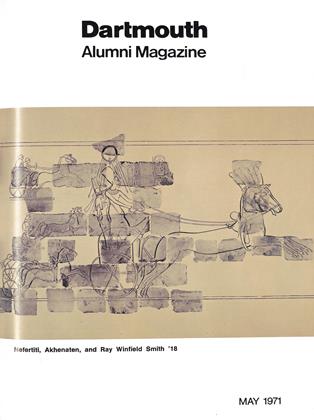RAY WINFIELD SMITH '18, now immersed in archaeology, is the modern counterpart of the Renaissance Man. "A modern college curriculum could well be patterned on your life" said the citation when he received Dartmouth's honorary Doctorate of Humane Letters in 1958. And indeed it could; in the 53 years since graduation he has been soldier, business executive, inventor, economist, scientist, aviator, linguist (six languages), State Department official, scholar, writer, lecturer, musician, sportsman, collector, and patron of the arts.
Possessor of one of the world's finest private collections of ancient glass, Mr. Smith took up this avocation when he was director of various Sinclair Oil subsidiaries abroad from 1919 to 1936 and later was head of his own importexport firm in Houston. One of his major gifts to Dartmouth is the large Greek amphora on display in Hopkins Center. Once the prize for the winning wrestler at the Panathenic Games, about 490 B.C., it is presented symbolically each year to the winner of the Ray W. Smith Award, which goes to the student whose life or work has added to the stature of the College.
Honored by General Pershing in World War I, Mr. Smith was staff officer to General "Hap" Arnold of the U.S. Air Force in World War II. In his service with the State Department after the war, he supervised the Marshall Plan in Berlin in 1951-52 and was U.S. Commissioner on the Military Security Board in Germany, 1952-55. Upon retirement he built his present mountaintop home in Dublin, N.H., not far from his native Marlboro.
Upon settling in New Hampshire, Mr. Smith took up at the state level his work as a Republican Party leader. He had been a member of the Republican Finance Committee in Washington, where he was executive head of the Eisen-hower-Nixon Club and an officer of the 1957 Inaugural Committee.
Mr. Smith is president of the Ray Winfield Smith Foundation, a Fellow of the German Archaeological Institute, former trustee of the Archaeological Institute of America, past chairman of the International Committee on Ancient Glass, former director of the American Research Center in Cairo, member of the Board of Visitors to the Boston Museum of Fine Arts, and council member of the American Association for the Advancement of Science. His writings have dealt mainly with ancient glass, and his Glass fromthe Ancient World is one of the standard reference books. Through research with the Brookhaven National Laboratory he has done pioneer work in the scientific dating of glass. Now his writing has turned to the Akhenaten Temple Project and he was the author of the November 1970 cover story for National Geographic.
Mr. Smith is an ardent Dartmouth sports fan. He saw every football game from 1955 to 1961, and when he flew home from Yugoslavia last October in time to make the Yale game, he probably set some sort of record for spectators at that contest. Mr. Smith won his "D" in track and was captain of the cross-country team. His younger son, Champney F. Smith '51 of Houston, added another "D" to the family collection, but his was in lacrosse.
On scaffolding 60 feetabove ground, Ray Smithis shown making the firstclose-up photographs evertaken of a relief-cut panelat the sandstone quarry ofSilsileh, the source almostcertainly of the sandstoneblocks used in the Akhenaten Temple.
 View Full Issue
View Full Issue
More From This Issue
-
 Feature
FeatureNefertiti, Akhenaten, and Ray Winfield Smith '18
May 1971 By John R. Scotford Jr. '38 -
 Feature
FeatureThe Dartmouth Institute
May 1971 -
 Feature
FeatureTrustees Vote to Consider Associated School for Women
May 1971 -
 Article
ArticleThe Undergraduate Chair
May 1971 By JOEL ZYLBERBERG '72 -
 Article
ArticleFaculty
May 1971 By WILLIAM R. MEYER -
 Article
ArticleHanover's Famous May "Murder"
May 1971







